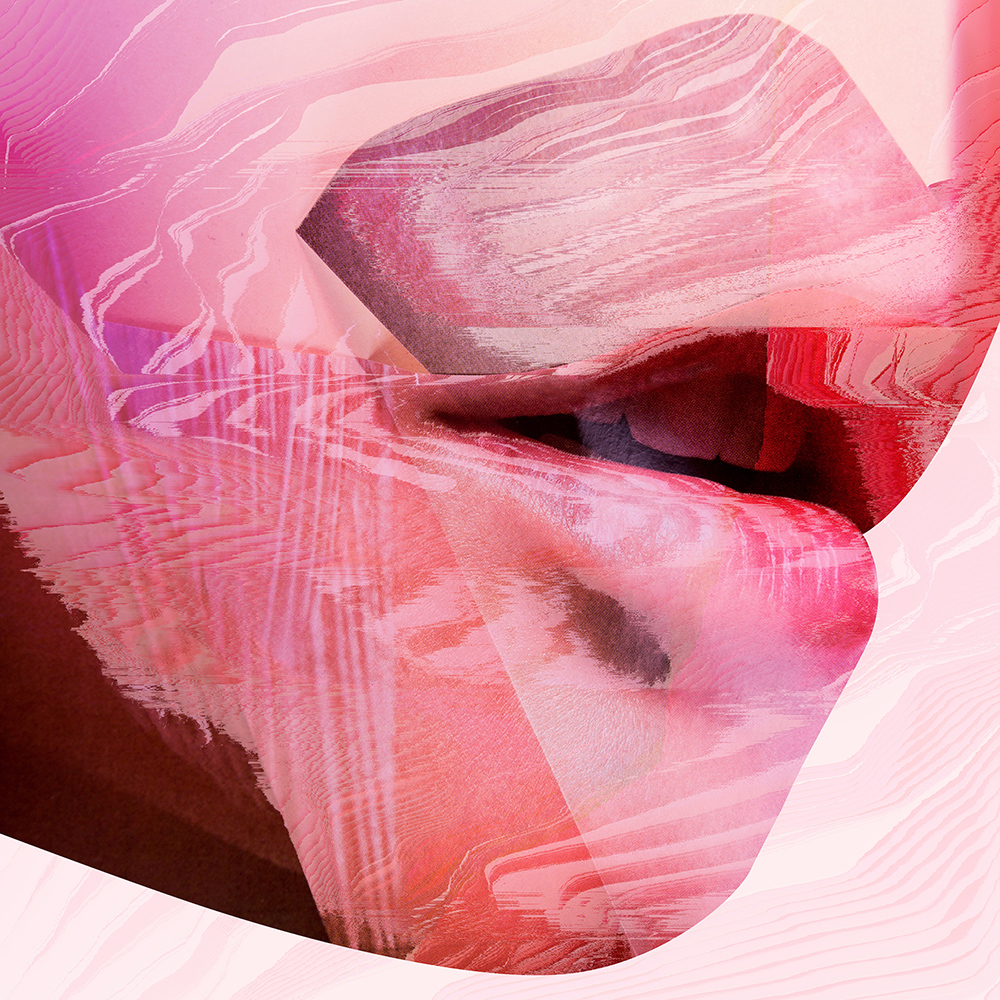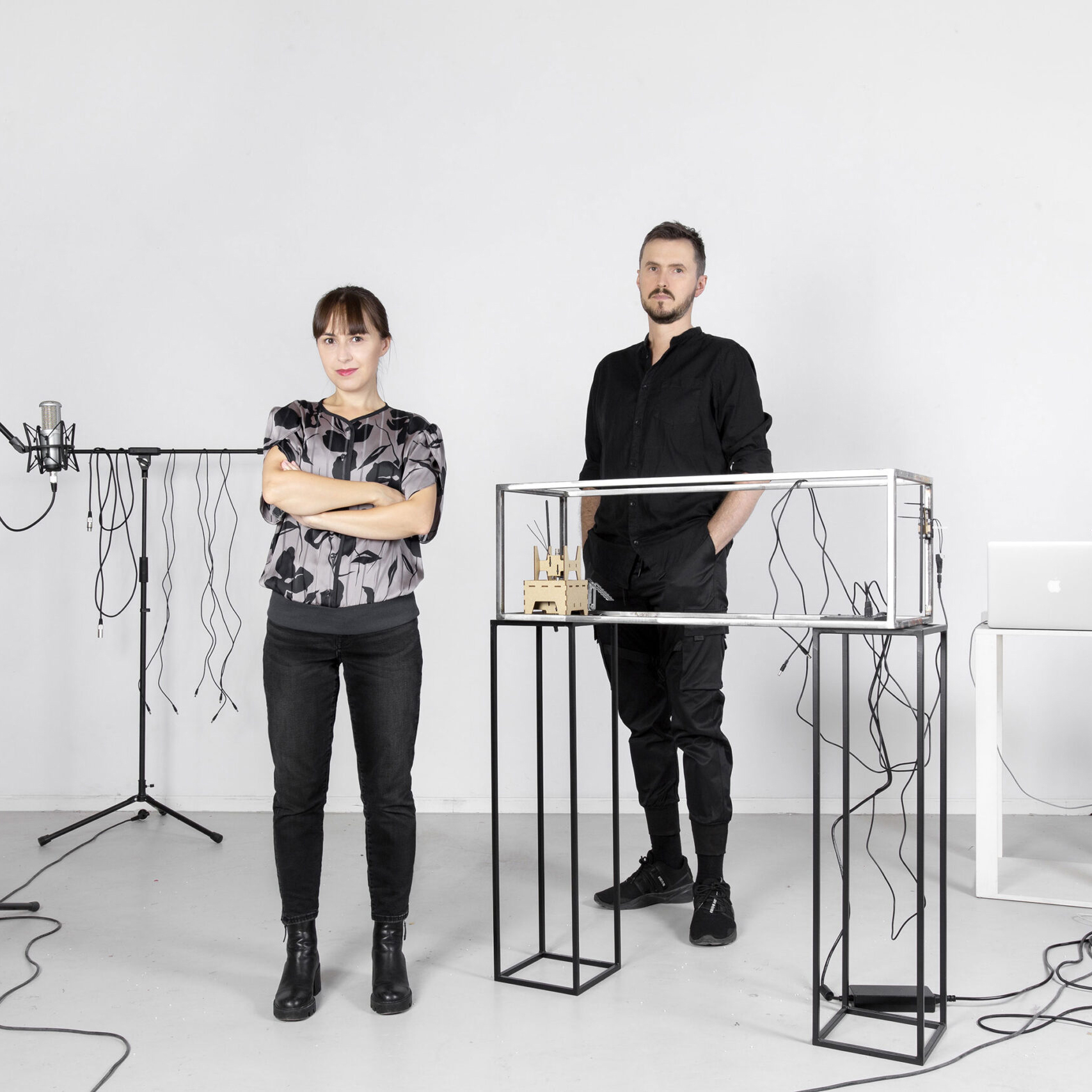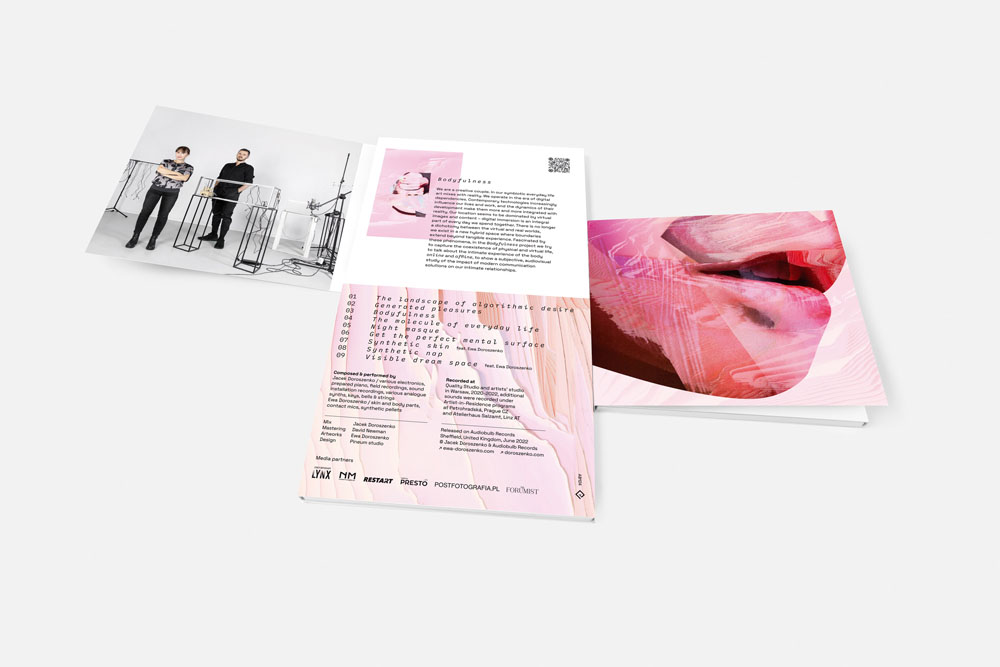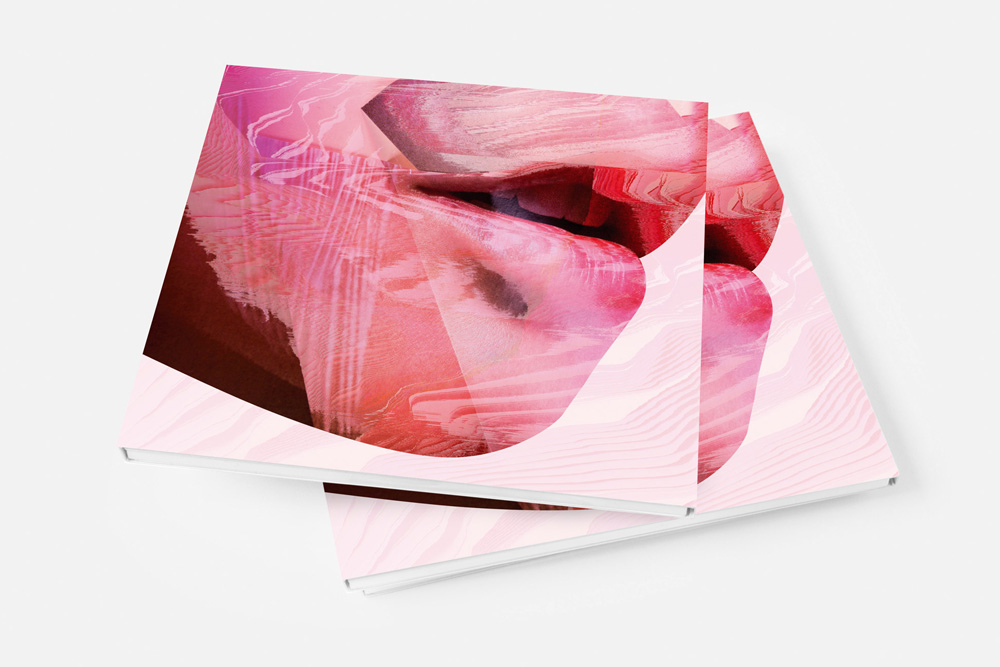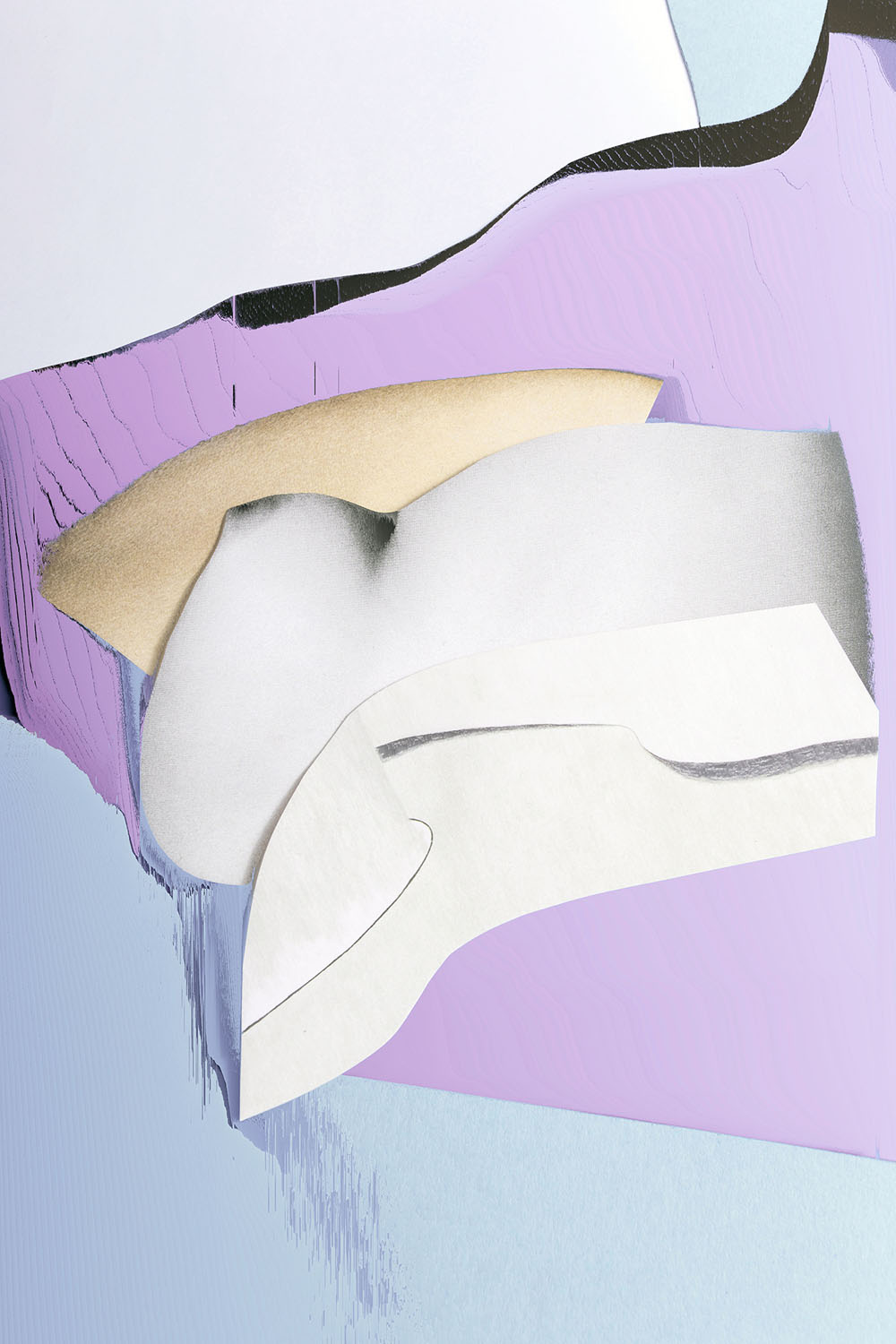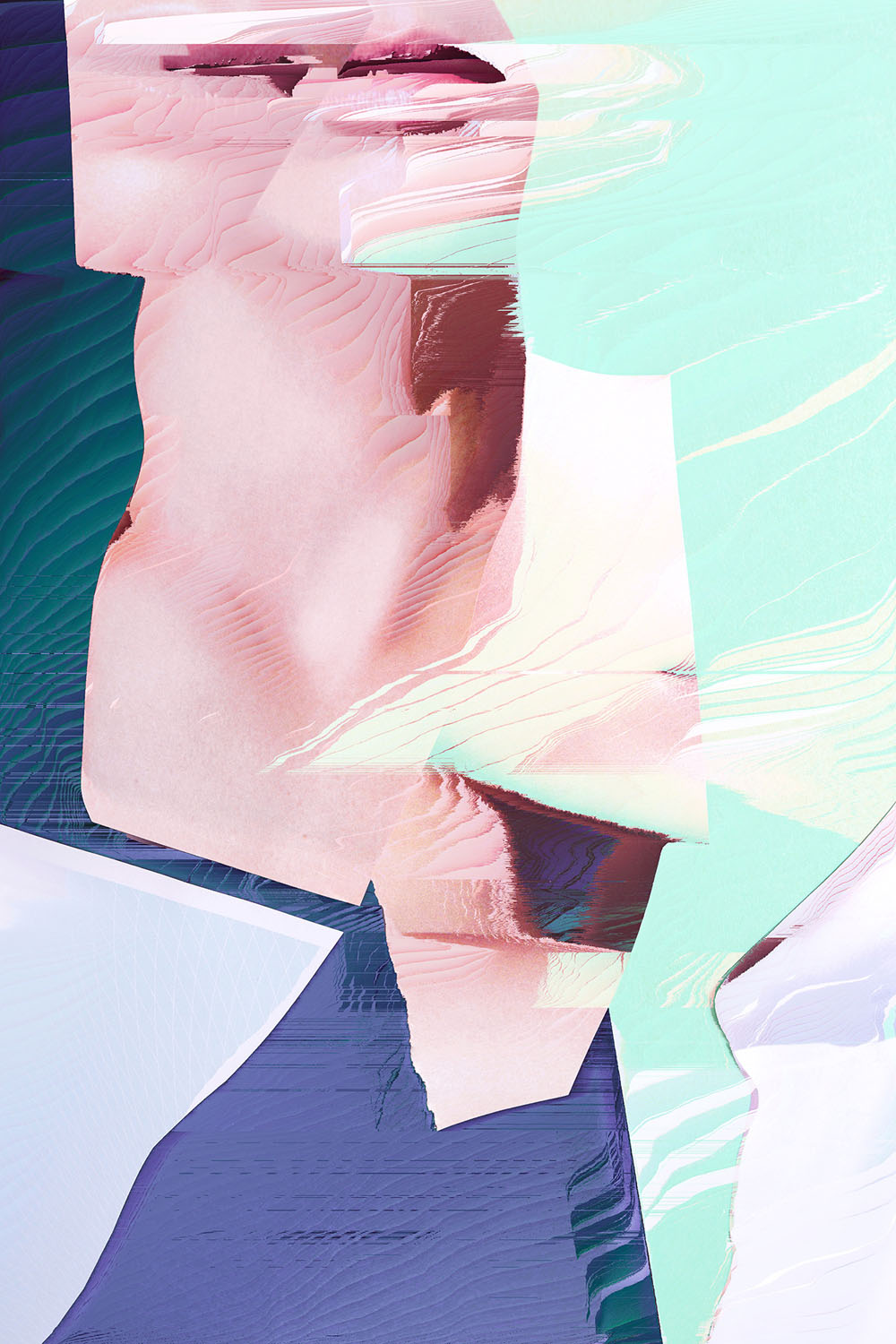Bodyfulness
The “Bodyfulness” consists of a series of photographs and musical compositions revealing the potentials and paradoxes of digital intimacy. The work is accompanied by video referring to popular online voice-guided meditations, whose listening is supposed to calm down, relax, or regain concentration. Both visual and sound works are based on recordings of our care and relaxation rituals, evening conversations, meetings, close-ups, including virtual ones – full of digital blurring, distortions, imperfections. Based on the performativity of these activities we experiment with the post-organic body to present audible carnality.
You can download the full PDF of the Bodyfulness project here.
1. The landscape of algorithmic desire
2. Generated pleasures
3. Bodyfulness
4. The molecule of everyday life
5. Night masque
6. Get the perfect mental surface
7. Synthetic skin
8. Synthetic nap
9. Visible dream space
We are a creative couple. In our symbiotic everyday life art mixes with reality. We operate in the era of digital dependencies. Contemporary technologies increasingly influence our lives and work, and the dynamics of their development make them more and more integrated with reality. Our location seems to be dominated by virtual images and content – digital immersion is an integral part of every day we spend together. There is no longer a dichotomy between the virtual and real worlds, we exist in a new hybrid space where boundaries extend beyond tangible experience. Fascinated by these phenomena, in the Bodyfulness project we try to capture the coexistence of physical and virtual life, to talk about the intimate experience of the body online and offline, to show a subjective, audiovisual study of the impact of modern communication solutions on our intimate relationships.
The project is also inspired by popular Internet practices: online guided meditations on the YouTube platform, ASMR session recordings with a multimillion viewership, naive self-improvement tutorials, smartphone apps for meditation and sleep. Despite technological progress, virtualization and digitalization of reality (or maybe because of it?) there is a growing interest in rituals and spiritual practices that allow to reach a state of deeper awareness or at least simulate it.
Jacek Doroszenko
Jacek is an artist active in the area of visual arts, working with sound and video. The core of his activity is treating sound phenomena as legitimate material in the field of visual art and emphasizing the value of listening as a practice. He received his Master of Arts degree at the Jan Matejko Academy of Fine Arts in Krakow. Jacek Doroszenko is a scholarship holder from the Minister of Culture and National Heritage of the Republic of Poland (2020) and a beneficiary of many residency programs, including Petrohradska Kolektiv in Prague (2018), Klaipeda Culture Communication Center (2017), Atelierhaus Salzamt in Linz (2016), The Island-resignified in Lefkada (2015), Kunstnarhuset Messen in Ålvik (2015), AAVC Hangar in Barcelona (2014). He presented his works in numerous venues, among others: Casoria Contemporary Art Museum in Napoli, Centre of Contemporary Art in Torun, Historic Centre of Athens, Goldcorp Centre for the Arts in Vancouver, Fait Gallery in Brno, Exgirlfriend Gallery in Berlin, Oskar Schindler’s Factory in Krakow, FIESP Cultural Center – Ruth Cardoso in Sao Paulo. He released music albums: Infinite Values, Time Released Sound, USA (2020), Āmurs, as Mammoth Ulthana, MCK PL (2018), Wide Grey, Eilean Records FR (2017), Soundreaming, Audiobulb Records UK (2017), Useful Remnants, self-release PL (2016), Particular Factors, as Mammoth Ulthana, Zoharum PL (2016), Mammoth Ulthana, as Mammoth Ulthana, Zoharum PL (2013), Nocturnes Online, City of Toruń PL (2011).
Ewa Doroszenko
Ewa is a Warsaw-based artist whose creative practice employs a mixture of painting, photography and digital media. She earned a Doctor of Fine Arts degree from the Nicolaus Copernicus University in Torun. Ewa Doroszenko is a scholarship holder from the Minister of Culture and National Heritage of the Republic of Poland (2019) and a winner of many international competitions, including Competition for the Fait Gallery Preview (2016); Young Lynxes Portfolio Competition – Contemporary Lynx (2018); DEBUTS 2018 – doc! photo magazine (2018); Debut – Lithuanian Photographers Association (2018). She is a beneficiary of many residency programs, including Petrohradska Kolektiv in Prague (2018), Klaipeda Culture Communication Center (2017), Atelierhaus Salzamt in Linz (2016), The Island-resignified in Lefkada (2015), Kunstnarhuset Messen in Ålvik (2015), AAVC Hangar in Barcelona (2014). Ewa Doroszenko presented her works in numerous venues, among others: Centre of Contemporary Art in Torun, Historic Centre of Athens, Vilnius Photography Gallery, MAH – Museum of Angra do Heroismo on the Azores, Goldcorp Centre for the Arts in Vancouver, Fait Gallery in Brno, Exgirlfriend Gallery in Berlin, FIESP Cultural Center – Ruth Cardoso in Sao Paulo. Her works have been published by the likes of Der Greif, Vice, NEO2, The Forumist, Detroit Center for Contemporary Photography, The Calvert Journal, Daily Serving, Metal, Contemporary Lynx, Flat Magazine, Juxtapoz, YET magazine. E
Interviews & Reviews
CLOT
Ewa Doroszenko’s practice enmeshes material and virtual realities. She works analog and digital. Her creative process spans from prints and video works to printed objects that question human life’s duality, as a brain-body jumping between virtually and physically constituted environments. The resulting images are innovative and classic, manipulated through the screen, photographed and painted. They all embrace controversial qualities of the contemporary moment, ‘web fluid culture’ as the artist calls it.
For Ewa Doroszenko, the digital highlights true human desires even more. The longing for experiences activated by all five human senses is still as intense as it was when not accessed through electronic equipment. We cannot escape the fact that we are rooted in materiality as bones and flesh, even though the computer-generated image continuously captures our consciousness.
The undeniable human need to interact with the natural landscape is extensively explored with her frequent collaborator, Jacek Doroszenko. In their recent exhibition How to Travel at the Propaganda Gallery in Warsaw, they reflected together on online travels, a topic especially pertinent in the day of the global pandemic. Bringing to mind Jorge Luis Borges’ short story on Art of Cartography, in which the map’s perfection outshines the territory, How to Travel highlighted blurs, distortions, and imperfections that digital maps, computer games or tourist guides contain. The project tested the boundaries of formal possibilities of imagery of virtual voyages of the peasant day.
Exercises of listening is another example of the committed collaboration between Ewa and Jacek Doroszenko. The multimedia installation consists of graphic works through which Ewa responds to the sonic environment created by Jacek. They bring to the fore the vibrational nature of material reality. Sharing their roles, working with each other, and sound in concert with image, their unison choreography points to the fact that listening does not necessarily mean to hear, or that to see one might need first to learn how to listen to images. Their collaborative experiments in sound and visual art originate in their shared sensitivity, precision and discipline.
Ewa Doroszenko has also been dedicated to in-depth research into standards of beauty. The Promise of Sublime Words is an ongoing series of photographic prints and GIF files that uncover the obscure subjects of museological hierarchy, photographic reproduction, and beauty standards by manipulating images derived from Antique or Classicism. Further investigation into beauty standards and more specifically into a contemporary obsession with the feminine digital image is shown by the digitally manipulated images Body Editor.
Even though there is no right or wrong use of technology, Ewa and Jacek Doroszenko’s work presents us that contemporary technology opens the digital doors to greater artistic freedom and potential creativity. Often discussing the negative impact of technology on the contemporary human, such as withdrawal from life in the public or unhealthy habits, one should not forget that the digital is also another space for the vulnerable to reclaim their image, for women to object the phallocentric gaze and for everyone to experience the emancipatory effects of pure-play.*
Contemporary Lynx
In June this year, the UK-based Audiobulb label will release a new album, Bodyfulness by Jacek Doroszenko, known for his Soundreaming project, solo albums on the French Eilean label and the American Time Released Sound, and the Mammoth Ulthana duo. This time the musician invited Ewa Doroszenko, an intermedia artist, with whom they work together in the field of contemporary art, travel as part of Artist-in-Residence, and create joint exhibitions.
Bodyfulness consists of a series of digital photographs and musical compositions that reveal the potentials and paradoxes of digital intimacy. The works are accompanied by a video that refers to popular online guided meditations, listening to which helps to relax or concentrate. The sound compositions are partly based on recordings of daily beauty and relaxation rituals, evening conversations, meetings, close-ups, including virtual ones – full of digital blurs, distortions, and imperfections. Building on the performativity of these activities, the artists experimented with the post-organic body to present their own version of sonic corporeality.
The instrumentation used in the recordings goes beyond classical electronic sound – Jacek Doroszenko: electronics, prepared piano, field recordings, recordings of sound installations, analogue synthesizers, bells, string instruments; Ewa Doroszenko: skin and body parts, contact microphones, synthetic granules. This specific mixture made it possible to perform compositions of an intimate and saturated character. Closely recorded musical activities and those that by their repetition imitate music or bypass this category direct the Bodyfulness project towards sound art.
Monolith Cocktail
It is May. I am penning this review when my tissue tethers to the touchscreen. My hands pixelate to dissipate into my keyboard. I centrifuge away on algorithms and platforms. My consciousness becomes collective. My flesh is cast aside. I am husked hollow and left as a digitalised hide. It is here in this virtual space that I encounter Bodyfulness.
I am met by art: first, a lenticular and lipless fleshy lower face; then, a predominance of pink and bluish blushes and hazy ribbon-like photographs pushed into position. There are prints of arms. I see hands handling hands. Are these the same hands that play the fluted-key flourishes on Landscape of Algorithmic Desire? They are husky and light. Ghostly background clicks are fleeting and apparition-like. They reappear as the gentle euphoria that blends into the pulsing syncopation of Generated Pleasures. Sub-bass melodies emerge, merge and exit reimagined. It is this symbiosis of the analogue and sounds from the natural world on Bodyfulness that fills me. Composed as a critique of digital intimacy, it is a distorting melange of imagery and music. At times there is opposition. For example, the opaque drones on the title track and depths of analogue on Night Masque contrast starkly with the clarity of the field recordings of water on The Molecule of Everyday Life. The album finale – Visible Dream Space – is dissonant. A slightly off-key synth sequence brims away into nothingness. It disconnects me from the melodia and fusion of what preceded it.
The Dorozenkos’ triumph though is their mid-album triptych. A dreamlike nostalgia weeps and stoops over the sun-kiss and splash of past summers on Get The Perfect Mental Surface. Bells are part-sung atop heavy production and dart around a Rhodes piano and subtle bass melody on Synthetic Skin. This complex symphony weaves and weaves some more until it is shocked into life by two clear bells. Oh these bells! How they sing! I could write poetry about them. They pitch high and are kept momentarily afloat by the fleeting breath of a string section that twists away into the earthy distance. Synthetic Nap is the entr’acte: analogue synths hum and thrum and bass and turn and twist and heighten and heighten higher to steeple and quieten and quieten further to silence to further silence and still.
Slow Music Movement
Exploring the increasingly blurred intersection of our real & virtual lives, Jacek & Ewa Doroszenko gently guide you into contemplating your changing reality before increasing the intensity, forcing you to question the Web 3.0's guiding hands & motivations in this appropriately ambient electronic meditation on modern living for Audiobulb, with Ewa intriguingly somehow contributing her skin & body parts to the project.
Vital Weekly
The cover of this CD has a short introduction about the ideas behind the music. Something about 'digital dependencies', "our action seems to be dominated by virtual images and content" and that in 'Bodyfulness' they try "to capture the coexistence of physical and virtual life, to talk about about the intimate experience of the body online and offline, to show a subjective, audiovisual study of the impact of modern communication solutions on our intimate relationships. Say what? It reeks, for me, of mindfulness, also something that I do not have much interest in. Sometimes you wish you didn't read such things. I know I can complain about the lack of information but knowing that Jacek Doroszenko plays "various electronics, prepared piano, field
recordings, sound installation recordings, various analogue synthesizers, keys, bells and strings" would have been enough as the playing of "skin and body parts, contact mics, synthetic pellets" by Ewa Doroszenko raises a few questions. And there isn't an answer anywhere. Is there some kind of live processing going on, I wondered. Her work features on two of the nine pieces here, but playing these, I couldn't detect anything different than the ones by Jacek solo. This is an Audiobulb Records release, which means we are in the world of computer processing, click n cuts, granular synthesis and such. It all has that ambient glitch feeling that music had some twenty years ago and which may have gone out of fashion a long time go. Maybe it is about time for a revival? Maybe this is already happening. I am hardly interested in what is in or out of fashion, and I am merely interested in great music. That we find on this CD. Doroszenko plays some wonderful ambient music, abstract and melodic
.
They go hand in hand with the 'real' instruments, their processed variations and field recordings. Throughout, this is very easygoing music, without a dissonant, a peep or a scratch. If we need to mention the analogue and the digital thing again, this album is a fine example. You recognize things, and sometimes you don't; the same thing one has with the real and the virtual. Quiet and pleasant music, perfect pass time music, the soundtrack for modern living. (FdW)
Photoworks
Polish artists Ewa and Jacek Doroszenko met on a residency programme in Italy and have been married for over ten years. Both originally trained as painters, but now make work across the spectrum of contemporary media together and individually. They are inspired by a common interest in contemporary technological reality. Their most recent project, Bodyfulness, combines photographs and gif-files made by Ewa and an album of musical compositions by Jacek and considers the potentials and paradoxes of digital intimacy. Photography+ caught up with them to find out more.
Photography+: What are the main themes of Bodyfulness?
Ewa Doroszenko: With this project, we address intimacy and closeness in today’s technology-dominated reality. We try to capture the coexistence of physical and virtual life, talk about the private experience of the body online and offline, and show a subjective audio-visual study of how contemporary technology and culture modify our intimate relationships.
P+: How did you create the images?
ED: The photographs represent scenes from our everyday and digital lives. I used photography as a starting point then used digital tools, juxtaposing images of the body into harmonious compositions, creating traditional and digital collages, and manipulating the photographic prints. I tried to leave visible traces of digital processing, partly revealing my working methods.
The sound part of the project is a set of pieces composed by Jacek, which was released in summer 2022 as a full album by the British label Audiobulb. The soundtracks are based on recordings of daily beauty and relaxation rituals, evening conversations, encounters, and close-ups, including virtual ones – full of digital blurs, distortions, and imperfections.
P+: I love the gifs. Why did you want to create them?
ED: Gifs are also images, I treat them equally to other forms of contemporary photography. I think of photography in terms of technology, as a medium that influences the way we perceive reality, but first and foremost I think of it in terms of images. I grew up in a family of photographers surrounded by photography and even then, before the digital revolution, I was amazed by the sheer number of images. That led me to believe that photography could be almost anything.
P+: I was interested in a phrase you use to talk about your project: ‘the post-corporeal body’. What does it mean?
Jacek Doroszenko: Astonishing changes are taking place in culture and science, which mean we need a new definition of the term ‘body’. Human corporeality and cognitive capacities are being expanded through technology and science, including nanotechnology, biotechnology, cognitive science, artificial intelligence, and augmented and virtual reality. Intellectual processes, memory, and sensory experience are no longer exclusively embodied areas, they have been diffused into networks of human-technology interaction.
P+: You have also said that there is no longer a division between the virtual and the real, that we now live in a hybrid space. Could you explain more?
JD: Contemporary Western culture can be described by the term ‘cyberculture’ because the division between virtual and real is less and less valid. Living in a cyberculture forces people to constantly change their identities – we experience this when we contribute to social media, play online games, and post digitally edited photos of ourselves. In addition, new technologies such as genetics, nanotechnology, and bioengineering are breaking down the previous limitations of the body. These issues are addressed by one of the contemporary directions in philosophy and culture, ‘transhumanism’. From the transhumanist point of view, humans are a flexible organism whose civilisational development has allowed them to enter a phase of self-evolution for the first time.
EW: Technology is an inseparable part of everyday modern life and – whether we want it to or not – influences our work, leisure, and private relationships. The pandemic and a digital transformation are having a huge impact, so there is also a great change in culture and art. Reality is increasingly challenged by the virtual worlds and technologies are developing fast, and I think artistic productions are also becoming more engaging and intermedial. New tools allow us even more artistic freedom, offering entirely new possibilities for creation.
P+: Did you make Bodyfulness at home?
JD: Most of the work was created in our flat and studio in Warsaw, the spaces where we feel most safe. But many of the motifs come from our virtual activity, when one of us was away and we were in touch thanks to technology. This virtual space gave us a substitute for the real space of the home, and even the illusion of closeness. As artists, we travel frequently and, using artist residencies, often change where we live. We have concluded that we always take our ‘mental atelier’ with us.
P+: Is science fiction an interesting lens through which to look at your work?
JD: It seems to us that artists have always been involved in predicting the future, intuiting the direction of science and technology and showing the impact of these achievements on individuals and societies. We cannot leave all knowledge in the hands of a small group of initiated scientists, politicians, and businesspeople. All members of society should participate in the debate about our future, because it concerns us all. Contemporary artists can help to actively inform, by critically diagnosing culture and entering into dialogue with scientists. Our creations are our voice in the debate on contemporary and future variants of existence, so our work can certainly be considered science fiction.
P+: Is there a link between home and identity? Does the penetration of the digital into the intimate reduce national differences, for example?
ED: Our project is about our private relationship, but there may be something in our story that other couples also experience. The unexpanded real world often loses its appeal for technicised young people, because it offers far less stimulation of the senses than virtual worlds. This breeds indifference to sensory input from what is more natural or mundane. Real interactions can become less attractive than those created digitally, in which the body is separated from its surroundings yet connected to advanced technology.
JD: In my opinion the digital revolution negatively affects our sense of identity, because it detaches us from our roots and embeds us in a very attractive and rich online reality to which we are not adapted. The brain has an incredible capacity to handle many diverse processes in parallel but we are unable to focus on multiple things at the same time. Jumping between tasks, including switching between the physical and virtual realms, is less efficient than paying attention to a single activity.
We do not yet know for sure how the stream of information affects our behaviour, but it may be that digitalisation affects us more deeply than we think. On the other hand, the fact that our habits are now changing, and we get the impression that technology is having an impact on our memory and attention, doesn’t mean that the connections in our brain structures are changing in some dangerous way.
P+: Does it matter if external forces influence our intimate behaviour?
JD: We are embedded in certain cultures so, beyond our purely biological conditions, our actions are determined by environmental influences. Our bodies are just a part of the vast fabric. People now accept a certain level of accessibility to their intimate sphere, the boundary of access is shifting. We think of our project as a small rite of passage preparing us for a biotechnological, trans-humanist journey towards total virtuality.
Postfotografia
Bodyfulness to nie tylko album z kompozycjami muzycznymi, ale również projekt wizualny, w którym artyści starają się uchwycić atmosferę teraźniejszości fizycznej, a zarazem wirtualnej. Ewa Doroszenko przygotowała serię zmysłowych fotografii cyfrowych i wzięła udział w nagraniach wybranych utworów.
PrzeKroj
Bodyfulness to audiowizualny projekt łączący fotografie oraz pliki GIF autorstwa Ewy Doroszenko oraz album z kompozycjami muzycznymi Jacka Doroszenko.
Jesteśmy kreatywną parą. W naszej symbiotycznej codzienności sztuka miesza się z życiem. Działamy w erze cyfrowych zależności. Współczesne technologie w coraz większym stopniu wpływają na nasze życie i pracę, a dynamika ich rozwoju sprawia, że są coraz bardziej zintegrowane z rzeczywistością. Nasze położenie wydaje się zdominowane przez wirtualne obrazy i treści – cyfrowa immersja jest nieodłącznym elementem każdego dnia, który wspólnie spędzamy. Zafascynowani tymi zjawiskami, w projekcie Bodyfulness staramy się uchwycić współistnienie życia fizycznego i internetowego, opowiedzieć o intymnym doświadczeniu ciała online i offline, pokazać w jaki sposób dzisiejsza kultura modyfikuje nasze intymne relacje.
W czerwcu 2022 nakładem wytwórni Audiobulb z Wielkiej Brytanii ukazał się album muzyczny pt. Bodyfulness. Zawarte w nim utwory są oparte na nagraniach naszych codziennych rytuałów, wieczornych rozmów, spotkań, zbliżeń, także wirtualnych – pełnych cyfrowych rozmyć, zniekształceń i niedoskonałości. Wykorzystując w nagraniach instrumentarium wykraczające poza klasyczne elektroniczne brzmienie przedstawiamy własną wersję dźwiękowej cielesności.
Ewa Doroszenko i Jacek Doroszenko
Ewa Doroszenko (ur. 1983) – artystka intermedialna, doktor sztuk plastycznych, mieszka i pracuje w Warszawie. Absolwentka Uniwersytetu Mikołaja Kopernika w Toruniu, stypendystka Ministra Kultury i Dziedzictwa Narodowego w 2019, laureatka wielu międzynarodowych konkursów, m.in. Preview – Fait Gallery Brno 2016, Debuts 2018 – doc! photo magazine, Debut 2018 – Lithuanian Photographers Association oraz finalistka m.in. Noorderlicht International Photo Festival 2021, Kranj Foto Fest 2021, International Festival of Photography FIF BH – Brazil 2020, Athens Digital Arts Festival 2020, GENERATE! Festival for Electronic Arts w Tübingen 2019. Rezydentka m.in. Re_Act contemporary art laboratory w Portugalii, The Island Resignified Lefkada w Grecji, Klaipeda Culture Communication Center na Litwie, AAVC Hangar Barcelona w Hiszpanii. Swoje prace prezentowała m.in. w Muzeum Współczesnym Wrocław, Galerii Sztuki Wozownia w Toruniu, Centrum Sztuki Współczesnej w Toruniu, Fait Gallery w Brnie, Galerii Propaganda w Warszawie, Exgirlfriend Gallery w Berlinie. ewa-doroszenko.com
Jacek Doroszenko (ur. 1979) – artysta audiowizualny, absolwent Akademii Sztuk Pięknych w Krakowie. Stypendysta Ministra Kultury i Dziedzictwa Narodowego 2020 oraz rezydent m.in. Kunstnarhuset Messen Ålvik w Norwegii, Atelierhaus Salzamt Linz w Austrii, Petrohradska Kolektiv Prague w Czechach, AAVC Hangar Barcelona w Hiszpanii. Uczestniczył m.in. w The Wrong New Digital Art Biennale w Rio de Janeiro, FILE Electronic Language International Festival w Sao Paulo, Transmission Arts Festival w Atenach, ISEA International Symposium on Electronic Art w Vancouver, Athens Digital Arts Festival w Atenach, Survival we Wrocławiu, R>>EJECT Radicals Festival w Rotterdamie, Open Source Art Festival w Sopocie, CoCArt Music Festival w Toruniu. Twórczość wizualna artysty odbija się echem w obszarze muzyki i sztuki dźwięku. Jego kompozycje muzyczne zostały wydane w formie albumów o międzynarodowym zasięgu, m.in. „Infinite Values”, Time Released Sound w USA; „Wide Grey”, Eilean Records we Francji, „Soundreaming” oraz „Bodyfulness”, Audiobulb Records w Wielkej Brytanii. doroszenko.com
Neo2
El músico polaco Jacek Doroszenko presenta su album Bodyfulness que cuenta con la participación de la artista multimedia Ewa Doroszenko.
La obra musical Bodyfulness está compuesta por una serie de fotografías y composiciones musicales que muestran las posibilidades y paradojas de la intimidad digital. El trabajo viene acompañado por un video que hace referencia a las populares meditaciones guiadas por voz, que encontramos en Internet, y cuya escucha se supone que calma, relaja o ayuda a recuperar la concentración.
Tanto el trabajo visual como la obra sonora se basan en sesiones de relajación de los propios artistas, así como en conversaciones nocturnas, reuniones y close-up repletos de borrosidad digital, distorsiones e imperfecciones. A partir de la performatividad de estas actividades podemos experimentar con el cuerpo posorgánico para presentar su propia versión de la corporalidad sónica.
La instrumentación utilizada en las grabaciones transciende los sonidos electrónicos clásicos.
Jacek se encarga de la parte electrónica, el piano preparado, las grabaciones de campo, grabaciones de instalaciones sonoras, sintetizadores analógicos, campanas, instrumentos de cuerda y Ewa, por su parte, se ocupa del sonido de la piel y las partes del cuerpo, de micrófonos de contacto y de gránulos sintéticos. Esta mezcla específica hizo posible realizar composiciones de carácter íntimo y saturado. Las actividades musicales estrechamente grabadas y aquellas que, en su repetición, imitan la música o eluden esta categoría encaminan el proyecto Bodyfulness hacia el arte sonoro.
Bodyfulness no es solo un album de composiciones musicales, también es una obra en la que los artistas intentan capturar la atmósfera de la presencia física y virtual. En este proyecto, Ewa Doroszenko colabora con una serie de fotografías sensuales y participa en la grabación de algunas piezas musicales.
Fascinados con la dicotomía entre el mundo real y el virtual y por la existencia de un espacio híbrido en el que las fronteras se extienden más allá de las experiencias tangibles.
Jacek y Ewa Doroszenko muestran con Bodyfulness un proyecto en el cual intentan registrar la coexistencia de la vida física y la virtual, hablando sobre la experiencia íntima del cuerpo online y offline y mostrando un estudio audiovisual subjetivo sobre cómo la tecnología y la cultura moderna pueden alterar nuestras relaciones íntimas.
Bodyfulness también está inspirado en las prácticas populares de Internet: meditaciones guiadas en YouTube, sesiones de ASMR con millones de espectadores, tutoriales simples de mejora personal y aplicaciones de meditación. A pesar del progreso tecnológico, la virtualización y la digitalización de la realidad, existe un interés en ascenso por prácticas rituales y espirituales que nos permiten alcanzar un estado de conciencia más profundo, o al menos que nos ayuden a simularlo.
Involucrado en proyectos como Soundreaming y Mammoth Ulthana , Jacek Doroszenko trata los fenómenos sonoros como material legítimo en el campo de las artes visuales, enfatizando el valor de la escucha como práctica. Ewa Doroszenko, conocida por obras como Body Editor o Radical Beauty, basa su práctica artística en manipulaciones digitales poco convencionales, combinándolas con medios tradicionales como la pintura y la fotografía. La artista también está involucrada en proyectos que exploran el fenómeno del sonido.
Como colectivo creativo, en su realidad diaria simbiótica, el arte se mezcla con sus propias vidas, trabajando en la era de las dependencias digitales.
Las tecnologías contemporáneas afectan a sus vida y a su trabajo cada vez más y la dinámica de su desarrollo los hace estar más integrados en la realidad, siendo su situación dominada por las imágenes y los contenidos virtuales.
Purple Haze
The project was inspired by the failures and bugs in the popular beauty apps, where unnatural bodies get distorted. While the Internet can seem like a place disconnected from the physical world, much of the activity that occurs there deeply affects how we feel outside of it. In the age of social media, technology provides women with tools that allow them to quickly create dream digital images of themselves. Using various beauty applications, they can smooth, contour their faces, whiten their teeth, add a few centimeters of height, enlarge their eyes, choose different mouths, and use many other options. Digitally edited images can serve as aspirational fantasies and occasionally they even can have a positive impact – when they are just effects of joyful entertainment. But can the game in which your body is a battleground be truly enjoyable? The phrase from Barbara Kruger’s iconic work has just as much resonance today as it did more than a quarter of a century ago.
While preparing the project I used photography as a starting point, alongside digital tools to create an expressive project that is both a critique and a celebration of the ongoing progress in contemporary technology and culture. I employed many methods of creating images: preparing three-dimensional collages constructed from free stock images and my portraits, photographing the scenes, printing in large sizes, physically manipulating prints, and digitally editing selected photos. In the final work, I tried to leave visible traces of digital processing, partly revealing my working methods to provoke discussion about contemporary photography.
How did you get into art?
I never doubted that I wanted to be an artist. Even as a child, I heard very often that I am very talented in drawing. Although my interests were quite broad and I liked science very much, the desire to create my own reality through art eventually won. I studied painting, which quickly became a basic medium in my projects, and finally, I got my doctoral degree in fine arts at the Nicolaus Copernicus University in Torun. During my studies, I also began to experiment with a conceptual approach to photography. I started to understand photography not as a single act of liberating the shutter, but as a sequence of resulting actions, which extends from aesthetic choices, the staging of scenes, physical and digital manipulation of images to the final arrangement of the exhibition. Currently, in my work, I use the consonance of many media – from photography to sound. I am constantly fascinated by art and its use as a kind of language.
What does art mean to you personally?
First of all, I try to use art to create new worlds, a reality different from that which surrounds me. Art is also my primary tool for researching and describing the issues of contemporaneity. I am primarily interested in the meaning of the image in technological reality and the fluidity of beauty standards. My artistic explorations are not limited by any medium, either traditional or digital. Trying to express my thoughts, I experiment with various methods and technologies. Whenever I think about creating new works, I try to create structures with multiple layers of meaning. The material choices are calculated and meant to bring on the idea.
Is there a goal you’re trying to accomplish?
Sure, I usually try to have clearly defined goals. Of course, as I grow and respond to a changing situation, I modify my goals. This makes it much easier for me to make decisions. On the other hand, there is a lot of room for experimentation in my artistic activity, so I often don’t know where the whole creative process will lead me. That is why I try to maintain a balance between planning activities and responding flexibly to the situation.
At the moment, together with my husband Jacek Doroszenko, we are working on a new project entitled „Bodyfulness“, which, like our previous activities, is a creative experiment combining sound and visual art. My goal is to release the project this year in a form of the unique music album and present an exhibition which is an audiovisual study of how modern technology and culture change our intimate relationships.
Do you have a life philosophy?
Yes, I have a certain philosophy of life. In a nutshell, it can be described as follows: I try to concentrate my energy on the things that depend on me. If I do something, I want to do it in the best and most professional way possible, regardless of whether my action is appreciated or not.
How do you think the art world will shape in the future?
The ongoing pandemic and simultaneous digital transformation have a huge impact on economic and social development. There are also great changes in the field of culture and art. As reality is increasingly being challenged by the virtual world and technologies are developing so rapidly, I think that in the future artistic productions will become more engaging and interactive. These new approaches and tools will perhaps allow even more artistic freedom, offering completely new creative opportunities, including the possibility of mixing elements that were probably impossible to combine before. I think that in the future, the physical experience of the exhibition will continue to be strong. But galleries will expand significantly in ways that are not just physical, but also digital.
